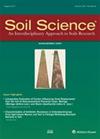封盖对城市土壤碳和养分的影响
4区 农林科学
Q2 Agricultural and Biological Sciences
引用次数: 12
摘要
摘要城市土壤因其提供碳储存和养分循环等生态系统服务的潜力而日益引起人们的兴趣。尽管如此,人们对不透水表面的土壤密封如何影响这些重要的生态系统服务的了解有限,这是城市环境中常见的干扰。本文研究了封土对土壤性质、土壤碳和土壤养分储量的影响。我们在英国曼彻斯特市对密封和未密封的绿地土壤进行了比较调查。结果表明,城市土壤的环境和人为添加物对土壤的性质和功能有很大的影响。总的来说,与绿地土壤相比,封闭减少了土壤碳和养分储量,然而,在人为添加有机和矿物人工制品的地方,这导致土壤碳和硝酸盐含量增加。人为添加导致的碳储量相当于或大于绿色空间的碳储量,具有潜在的稳定性和较长的停留时间。这表明,在有工业历史的地区,人为添加可能导致城市土壤中的遗留碳储存,并对城市土壤碳预算做出重要贡献。这些发现揭示了城市封闭土壤的异质性和人为人工制品对土壤功能的影响。我们的研究强调需要进一步了解城市土壤过程,包括封闭和非封闭土壤,以及人为添加对土壤功能和重要生态系统服务的影响和遗产。本文章由计算机程序翻译,如有差异,请以英文原文为准。
The effects of sealing on urban soil carbon and nutrients
Abstract. Urban soils are of increasing interest for their potential to provide ecosystem services such as carbon storage and nutrient cycling. Despite this, there is limited knowledge on how soil sealing with impervious surfaces, a common disturbance in urban environments, affects these important ecosystem services. In this paper, we investigate the effect of soil sealing on soil properties, soil carbon and soil nutrient stocks. We undertook a comparative survey of sealed and unsealed greenspace soils across the UK city of Manchester. Our results reveal that the context of urban soil and the anthropogenic artefacts added to soil have a great influence on soil properties and functions. In general, sealing reduced soil carbon and nutrient stocks compared to greenspace soil, however, where there were anthropogenic additions of organic and mineral artefacts this led to increases in soil carbon and nitrate content. Anthropogenic additions led to carbon stocks equivalent to or larger than those in greenspaces, potentially of a stable nature with long residence times. This suggests that in areas with an industrial past, anthropogenic additions can lead to a legacy carbon store in urban soil and make important contributions to urban soil carbon budgets. These findings shed light on the heterogeneity of urban sealed soil and the influence of anthropogenic artefacts on soil functions. Our research highlights the need to gain further understanding into urban soil processes, in both sealed and unsealed soils, and the influence and legacy of anthropogenic additions on soil functions and important ecosystem services.
求助全文
通过发布文献求助,成功后即可免费获取论文全文。
去求助
来源期刊

Soil Science
农林科学-土壤科学
CiteScore
2.70
自引率
0.00%
发文量
0
审稿时长
4.4 months
期刊介绍:
Cessation.Soil Science satisfies the professional needs of all scientists and laboratory personnel involved in soil and plant research by publishing primary research reports and critical reviews of basic and applied soil science, especially as it relates to soil and plant studies and general environmental soil science.
Each month, Soil Science presents authoritative research articles from an impressive array of discipline: soil chemistry and biochemistry, physics, fertility and nutrition, soil genesis and morphology, soil microbiology and mineralogy. Of immediate relevance to soil scientists-both industrial and academic-this unique publication also has long-range value for agronomists and environmental scientists.
 求助内容:
求助内容: 应助结果提醒方式:
应助结果提醒方式:


